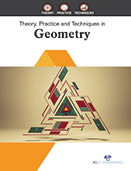Mathematics

Geometry, the part of mathematics, deals with the study of shapes, patterns and angles. It occurred in many languages and in all cultures and can be divided into plane geometry and solid geometry. The basic concepts of geometry are points and lines, angles, and polygons. Geometry is everywhere. Nature also has an abundance of geometry. Patterns can be found on leaves, in flowers, in seashells and many other places. Even our own bodies consist of patterns, curves and line segments. It is through the observation of nature that scientists have begun to explore and explain the more basic principles now accepted as scientific truths. This began with the simple repetitive patterns such as the orbiting of the planets or the back and forth motion of a pendulum. It continues today as new theorems and natural events are explained and represented through geometric representations, thinking and principles.
This book as the name suggests “Theory, Practice and Techniques in Geometry” aims to provide a lively and readable presentation of large parts of classical geometry. It delivers the knowledge of geometry of greater scope than the classical geometry taught today, which is no longer an adequate basis for mathematics or physics, both of which are becoming increasingly geometric. The text starts with building blocks of geometry. Next it deals with geometric constructions, triangle, and polygon properties, as well as dealing with the behavior of trigonometric functions; it closes with the measurement of perimeter and area of two-dimensional bodies. The text is intended to introduce readers to the major geometrical topics taught at undergraduate level in a manner that is both accessible and rigorous.